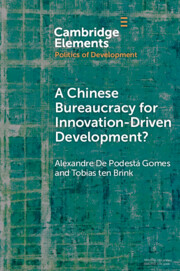196 results
How Do Toothless Tigers Bite? Extra-institutional Governance and Internet Censorship by Local Governments in China
-
- Journal:
- The China Quarterly , First View
- Published online by Cambridge University Press:
- 16 May 2024, pp. 1-20
-
- Article
-
- You have access
- Open access
- HTML
- Export citation
Frustration and fidelity: how public interest lawyers navigate procedure in the direct representation of asylum seekers
-
- Journal:
- Law & Society Review / Volume 58 / Issue 2 / June 2024
- Published online by Cambridge University Press:
- 16 May 2024, pp. 270-293
- Print publication:
- June 2024
-
- Article
-
- You have access
- Open access
- HTML
- Export citation
4 - Outsourcing Democracy through Professional Consulting
-
- Book:
- The New Experts
- Published online:
- 09 May 2024
- Print publication:
- 16 May 2024, pp 94-132
-
- Chapter
- Export citation
7 - Lineages of Governmentality
- from Part IV - The Evolution of Lawfare
-
- Book:
- The Violence of Law
- Published online:
- 30 April 2024
- Print publication:
- 02 May 2024, pp 294-358
-
- Chapter
- Export citation
The spectre of Ma Phyu? Loyalty, competence, and the spatial dynamics of imperial administration in colonial Burma
-
- Journal:
- Modern Asian Studies , First View
- Published online by Cambridge University Press:
- 12 April 2024, pp. 1-27
-
- Article
-
- You have access
- Open access
- HTML
- Export citation
Conclusion
-
- Book:
- Race, Taste and the Grape
- Published online:
- 16 March 2024
- Print publication:
- 28 March 2024, pp 312-319
-
- Chapter
- Export citation
5 - Bureaucracy without the State
-
- Book:
- Race, Taste and the Grape
- Published online:
- 16 March 2024
- Print publication:
- 28 March 2024, pp 148-180
-
- Chapter
- Export citation
Bureaucratic entrepreneurship: how frontline bureaucrats promote policy innovation
-
- Journal:
- Journal of Public Policy / Volume 44 / Issue 2 / June 2024
- Published online by Cambridge University Press:
- 04 March 2024, pp. 411-435
-
- Article
-
- You have access
- HTML
- Export citation
Inside the Black Box: Uncovering Dynamics and Characteristics of the Chilean Central Government Bureaucracy with a Novel Dataset
-
- Journal:
- Latin American Politics and Society , FirstView
- Published online by Cambridge University Press:
- 09 January 2024, pp. 1-29
-
- Article
-
- You have access
- Open access
- HTML
- Export citation
2 - Reconsidering the Good of Improving Accountability
- from Part I - (Re)theorising Accountability in EMU
-
-
- Book:
- Substantive Accountability in Europe's New Economic Governance
- Published online:
- 23 November 2023
- Print publication:
- 07 December 2023, pp 45-62
-
- Chapter
-
- You have access
- Open access
- HTML
- Export citation

Using the Police Craft to Improve Patrol Officer Decision-Making
-
- Published online:
- 06 December 2023
- Print publication:
- 21 December 2023
-
- Element
- Export citation
The Bureaucratic Politics of Urban Land Rights: (Non)Programmatic Distribution in São Paulo’s Land Regularization Policy
-
- Journal:
- Latin American Politics and Society , FirstView
- Published online by Cambridge University Press:
- 04 December 2023, pp. 1-27
-
- Article
-
- You have access
- Open access
- HTML
- Export citation
Chapter 5 - Beyond the Tyranny of Textual Space
-
- Book:
- Faulkner's Cartographies of Consciousness
- Published online:
- 02 November 2023
- Print publication:
- 16 November 2023, pp 145-178
-
- Chapter
- Export citation
9 - State Capacity and Property Rights
- from Part III - Institutional Obstacles to Structural Transformation
-
- Book:
- Institutional Challenges at the Early Stages of Development
- Published online:
- 09 November 2023
- Print publication:
- 09 November 2023, pp 288-315
-
- Chapter
-
- You have access
- Open access
- HTML
- Export citation
1 - Echoes of Empire
- from Part I - An Audible Empire
-
- Book:
- Music and the Making of Medieval Venice
- Published online:
- 12 October 2023
- Print publication:
- 26 October 2023, pp 19-41
-
- Chapter
- Export citation
31 - Bureaucratic Modes of Knowing in the Late Roman Empire
-
-
- Book:
- The Intellectual World of Late Antique Christianity
- Published online:
- 05 October 2023
- Print publication:
- 26 October 2023, pp 590-607
-
- Chapter
- Export citation
3 - Public Works, Publicity, and the Search for a New State-Idea
-
- Book:
- Ethical Empire?
- Published online:
- 05 October 2023
- Print publication:
- 19 October 2023, pp 92-122
-
- Chapter
- Export citation
Coping with the unforeseen: bounded rationality and bureaucratic responses to the COVID-19 crisis
-
- Journal:
- Journal of Public Policy / Volume 44 / Issue 1 / March 2024
- Published online by Cambridge University Press:
- 06 October 2023, pp. 24-43
-
- Article
-
- You have access
- Open access
- HTML
- Export citation
Was There an Administrative Revolution?
-
- Journal:
- Journal of Chinese History / Volume 8 / Issue 1 / January 2024
- Published online by Cambridge University Press:
- 31 August 2023, pp. 147-166
-
- Article
-
- You have access
- Open access
- HTML
- Export citation

A Chinese Bureaucracy for Innovation-Driven Development?
-
- Published online:
- 25 August 2023
- Print publication:
- 21 September 2023
-
- Element
- Export citation



